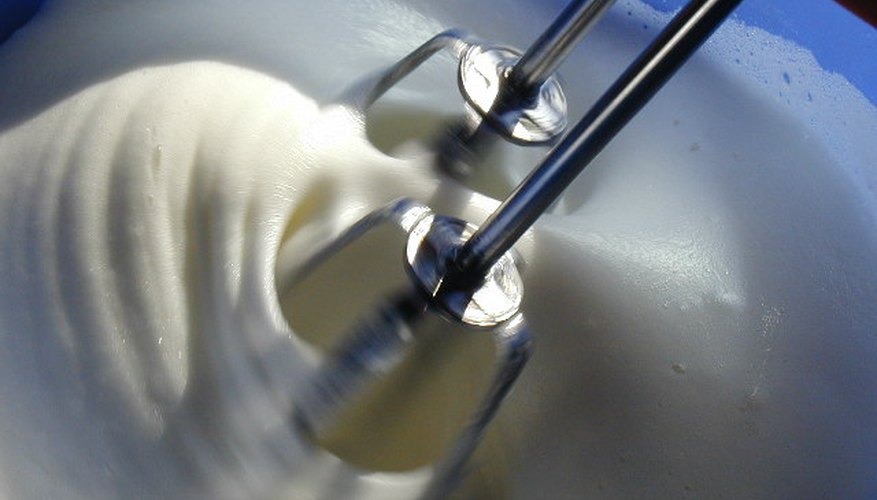Before the electric mixer came along, beating eggs and mixing cookie dough were done by hand with a whisk or spoon. Beating double cream into whipped cream was almost considered an event due to the effort and time it took. Thankfully, there is now a small kitchen appliance called the electric mixer that does most of the work for us.
Function
A mixer is a kitchen appliance that cooks use to mix, fold, beat and whip ingredients. A contemporary hand-held mixer typically comes with one or two removable beaters. A stand mixer, on the other hand, comes with three attachments--a dough hook to knead dough, a flat beater to mix batters and a wire whip to whisk ingredients like eggs. Attachments for pasta, fruit and veggie straining, food grinding, citrus juicing and sausage stuffing are also available for some higher-end stand mixers.
- A mixer is a kitchen appliance that cooks use to mix, fold, beat and whip ingredients.
- A stand mixer, on the other hand, comes with three attachments--a dough hook to knead dough, a flat beater to mix batters and a wire whip to whisk ingredients like eggs.
Hand-held Mixer
A hand-held mixer is meant to be held in a cook's hand. The handle is mounted over a motor that controls one or two beaters. The user controls how fast the beaters spin. Some hand-held mixers have three speeds; others have seven or more. Once plugged in and turned on, this type of electric mixer is good for mixing anything but thick cake or cookie doughs or yeast doughs. It also makes quick work of beating eggs and cream.
- A hand-held mixer is meant to be held in a cook's hand.
- The handle is mounted over a motor that controls one or two beaters.
Stand Mixer
The motor in a stand mixer is much more powerful than that of a hand-held mixer. As the name implies, a stand mixer is a mixer attached to a stand, leaving the cook's hands free to add ingredients as it mixes. Unlike a hand-held mixer, which can be stored in a cupboard or deep drawer, a stand mixer is meant to stand on your kitchen counter. It can handle much tougher jobs like thick doughs.
- The motor in a stand mixer is much more powerful than that of a hand-held mixer.
Size
A commercial electric stand mixer comes with bowls in excess of 100 quarts. Home models, however, come with bowls of 4 ½ to 6 quarts. For example, the KitchenAid Classic Series stand mixer comes with a 4½-quart bowl and a 250-watt motor; the head of the mixer tilts back to allow the cook to remove the hook, beater or whip. It weighs 12.2kg. By contrast, the Commercial 5 Series stand mixer comes with a 5-quart bowl and 450-watt motor. The bowl lifts up to the hook, beater or whip. It weighs 13.6kg. Both have 10 speeds. The hand-held mixer measures roughly 8 x 4 x 6 inches and can weigh around 1.36kg.
- A commercial electric stand mixer comes with bowls in excess of 100 quarts.
History
Herbert Johnston invented the first electric stand mixer in 1908, which was sold by KitchenAid. Within seven years, you could find his 80-quart version in most commercial bakeries. In 1919, home cooks were able to enjoy the convenience of a stand mixer in a much smaller version. The construction of the mixer has changed so little since 1919 that attachments made then will fit today's KitchenAid stand mixers, which are made in the same Greenville, Ohio, factory. It wasn't until 1952 that Sunbeam introduced the first hand-held electric mixer.
- Herbert Johnston invented the first electric stand mixer in 1908, which was sold by KitchenAid.
- The construction of the mixer has changed so little since 1919 that attachments made then will fit today's KitchenAid stand mixers, which are made in the same Greenville, Ohio, factory.
